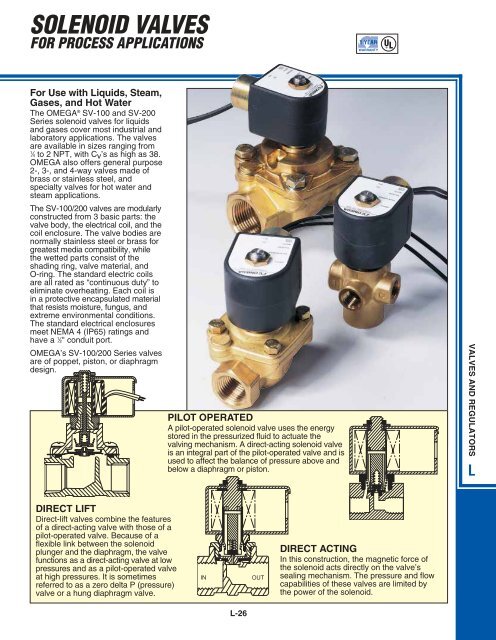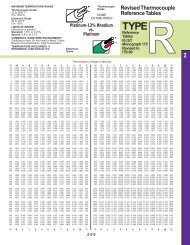SOLENOID VALVES
SOLENOID VALVES
SOLENOID VALVES
You also want an ePaper? Increase the reach of your titles
YUMPU automatically turns print PDFs into web optimized ePapers that Google loves.
<strong>SOLENOID</strong> <strong>VALVES</strong><br />
FOR PROCESS APPLICATIONS<br />
For Use with Liquids, Steam,<br />
Gases, and Hot Water<br />
The OMEGA ® SV-100 and SV-200<br />
Series solenoid valves for liquids<br />
and gases cover most industrial and<br />
laboratory applications. The valves<br />
are available in sizes ranging from<br />
1<br />
⁄4 to 2 NPT, with Cv’s as high as 38.<br />
OMEGA also offers general purpose<br />
2-, 3-, and 4-way valves made of<br />
brass or stainless steel, and<br />
specialty valves for hot water and<br />
steam applications.<br />
The SV-100/200 valves are modularly<br />
constructed from 3 basic parts: the<br />
valve body, the electrical coil, and the<br />
coil enclosure. The valve bodies are<br />
normally stainless steel or brass for<br />
greatest media compatibility, while<br />
the wetted parts consist of the<br />
shading ring, valve material, and<br />
O-ring. The standard electric coils<br />
are all rated as “continuous duty” to<br />
eliminate overheating. Each coil is<br />
in a protective encapsulated material<br />
that resists moisture, fungus, and<br />
extreme environmental conditions.<br />
The standard electrical enclosures<br />
meet NEMA 4 (IP65) ratings and<br />
have a 1 ⁄2" conduit port.<br />
OMEGA’s SV-100/200 Series valves<br />
are of poppet, piston, or diaphragm<br />
design.<br />
PILOT OPERATED<br />
A pilot-operated solenoid valve uses the energy<br />
stored in the pressurized fluid to actuate the<br />
valving mechanism. A direct-acting solenoid valve<br />
is an integral part of the pilot-operated valve and is<br />
used to affect the balance of pressure above and<br />
below a diaphragm or piston.<br />
<strong>VALVES</strong> AND REGULATORS<br />
L<br />
DIRECT LIFT<br />
Direct-lift valves combine the features<br />
of a direct-acting valve with those of a<br />
pilot-operated valve. Because of a<br />
flexible link between the solenoid<br />
plunger and the diaphragm, the valve<br />
functions as a direct-acting valve at low<br />
pressures and as a pilot-operated valve<br />
at high pressures. It is sometimes<br />
referred to as a zero delta P (pressure)<br />
valve or a hung diaphragm valve.<br />
DIRECT ACTING<br />
In this construction, the magnetic force of<br />
the solenoid acts directly on the valve’s<br />
sealing mechanism. The pressure and flow<br />
capabilities of these valves are limited by<br />
the power of the solenoid.<br />
L-26
SELECTING A <strong>SOLENOID</strong> VALVE<br />
TO YOUR SYSTEM SPECIFICATIONS<br />
SELECTION GUIDELINES<br />
General purpose solenoid valves are<br />
used with a wide variety of liquids<br />
and gases in a broad spectrum of<br />
applications. Rating the valve<br />
capacity in terms that relate to all<br />
operating conditions is done by<br />
determining the flow factor (Cv) of<br />
the valve. The Cv value is the<br />
number of U.S. gallons of 60°F water<br />
per minute that, when flowing through<br />
the valve, causes a pressure drop of<br />
1 psi. This measure of capacity is<br />
stated for each model in this handbook.<br />
There are 5 main parameters to<br />
consider when selecting a valve:<br />
Cv, media compatibility, pressure,<br />
temperature, and process fitting. For<br />
each of these parameters, maximum<br />
values are listed for each valve. To<br />
choose the correct valve, compare<br />
each parameter and check that it is<br />
less than the maximum value listed.<br />
LIQUID APPLICATIONS<br />
For most applications, liquids are<br />
considered incompressible and only<br />
the following factors need be<br />
considered in sizing a valve:<br />
Cv = Flow factor of valve<br />
Q = Flow expressed in U.S. gallons<br />
per minute (GPM)<br />
P = Pressure drop across the valve<br />
= P 1 – P 2<br />
P 1 = Inlet pressure psig<br />
P 2 = Outlet pressure psig<br />
G = Specific gravity of the fluid<br />
(G = 1.0 for water at 60°F)<br />
These factors relate as shown in<br />
the following equation:<br />
Cv = Q<br />
G<br />
P<br />
Sample Problem: A 2-way<br />
normally closed valve is needed<br />
to control the transfer of a liquid<br />
(G = 1.1) at a rate of 2 GPM.<br />
The pressure available is 10 psi;<br />
downstream pressure is 0 psi.<br />
Solution:<br />
P = P 1 – P 2 = 10 - 0 = 10 PSI<br />
Cv = Q<br />
G<br />
P<br />
Therefore, a valve is needed with<br />
a Cv of at least 0.67, and a<br />
maximum operating pressure<br />
differential of at least 10 psid.<br />
Referring to the general purpose<br />
valves starting on page L-28, the<br />
SV105 with a Cv = 0.75 is<br />
acceptable. Check temperature,<br />
media compatibility, and end fittings<br />
to ensure a correct valve choice.<br />
Note: The Cv values given in this handbook are applicable<br />
to liquids with viscosities to 100 SSU (22 centistokes).<br />
GAS APPLICATIONS<br />
When compressible media such as<br />
air or gases are used, the sizing of<br />
the valve must include additional<br />
factors that affect performance:<br />
Cv = Flow factor<br />
Q = Flow expressed in standard<br />
cubic feet per hour (SCFH)<br />
P = Pressure drop across the<br />
valve (inlet to outlet) in psid<br />
P 1 and P 2 = Inlet and outlet absolute<br />
pressures, respectively (psia)<br />
psia = Gage pressure + (14.7 psia)<br />
t = Gas temperature (ºF)<br />
G = Specific gravity of gas<br />
(G = 1 for air at 55°F)<br />
These factors relate as shown in the<br />
following equations:<br />
If (0.53) P 1 < P 2<br />
Cv =<br />
Q<br />
1349<br />
= 2<br />
If (0.53) P 1 ≥ P 2<br />
Cv =<br />
Q (460 + t) x G<br />
704 x P 1<br />
Sample Problem: A normally closed<br />
2-way valve is needed to control gas<br />
entering a furnace. Also known:<br />
Q = 500 SCFH G = 0.7 t = 60°F.<br />
P 1 = 35 psia or (20 psig + 14.7)<br />
P 2 = 30 psia or (15 psig + 14.7)<br />
Solution:<br />
P = 35 - 30 = 5 psid<br />
P 1 (0.53) = 35 (0.53) = 18.55 < P 2<br />
L-27<br />
1.1<br />
10<br />
(460 + t) x G<br />
P x P 2<br />
= 0.66<br />
=<br />
Therefore, use the formula<br />
Cv =<br />
Q<br />
1349<br />
Cv = 0.58<br />
Therefore, a valve is needed with<br />
a Cv ≥0.58 and a maximum operating<br />
pressure differential ≥5 psid.<br />
Again, the general purpose stainless<br />
steel SV105 with a Cv = 0.75 is<br />
sufficient, and temperature and<br />
media compatibility are good.<br />
Sample Problem: A 3-way<br />
normally closed valve is needed to<br />
control a single-acting spring return<br />
cylinder. Known are:<br />
Q A = 28.3 cubic in/s at 56 psig to<br />
obtain 2" stroke of a 6"<br />
diameter cylinder in 2 s<br />
P 1 = 115 psia or (100 psig + 14.7)<br />
P 2 = 71 psia or (56 psig + 14.7)<br />
(for a 1600 lb force)<br />
G = 1 for air, t = 90°F<br />
P = 115 - 71 = 44 psid<br />
Since the flow was determined at<br />
a pressure of 56 psig, it must be<br />
converted to its equivalent volume<br />
at standard pressure. Boyle’s law<br />
for converting to standard<br />
conditions:<br />
P<br />
Q S = Q A 515<br />
A ( P S ) ( t + 460)<br />
= 127 standard cubic inches<br />
per second<br />
Where Q is flow<br />
P is pressure in psia<br />
A is for actual conditions<br />
S is for standard conditions<br />
Converting this to SCFH:<br />
Q = 127<br />
= 265 SCFH<br />
Select the Cv formula using:<br />
P 1 (0.53) = 115 (0.53) = 60.95 < P 2<br />
Cv =<br />
265<br />
1349<br />
in3<br />
s<br />
(460 + t) x G<br />
P x P 2<br />
s – ft<br />
( 3<br />
in 3 – hr )<br />
x 208<br />
550 x 1<br />
44 x (56 + 14.7)<br />
= 0.083<br />
Therefore, valve SV241, which<br />
has a Cv = 0.18, max MODP =<br />
150 psid, and max temp = 165°F,<br />
will work.<br />
=
One Omega Drive | Stamford, CT 06907 | 1-888-TC-OMEGA (1-888-826-6342) |<br />
www.omega.com<br />
info@omega.com<br />
UNITED KINGDOM<br />
www. omega.co.uk<br />
Manchester, England<br />
0800-488-488<br />
UNITED STATES<br />
www.omega.com<br />
1-800-TC-OMEGA<br />
Stamford, CT.<br />
CANADA<br />
www.omega.ca<br />
Laval(Quebec)<br />
1-800-TC-OMEGA<br />
FRANCE<br />
www.omega.fr<br />
Guyancourt, France<br />
088-466-342<br />
CZECH REPUBLIC<br />
www.omegaeng.cz<br />
Karviná, Czech Republic<br />
596-311-899<br />
GERMANY<br />
www.omega.de<br />
Deckenpfronn, Germany<br />
0800-8266342<br />
BENELUX<br />
www.omega.nl<br />
Amstelveen, NL<br />
0800-099-33-44<br />
More than 100,000 Products Available!<br />
Temperature<br />
Calibrators, Connectors, General Test and Measurement<br />
Instruments, Glass Bulb Thermometers, Handheld Instruments<br />
for Temperature Measurement, Ice Point References,<br />
Indicating Labels, Crayons, Cements and Lacquers, Infrared<br />
Temperature Measurement Instruments, Recorders Relative<br />
Humidity Measurement Instruments, RTD Probes, Elements<br />
and Assemblies, Temperature & Process Meters, Timers and<br />
Counters, Temperature and Process Controllers and Power<br />
Switching Devices, Thermistor Elements, Probes and<br />
Assemblies,Thermocouples Thermowells and Head and Well<br />
Assemblies, Transmitters, Wire<br />
Flow and Level<br />
Air Velocity Indicators, Doppler Flowmeters, Level<br />
Measurement, Magnetic Flowmeters, Mass Flowmeters,<br />
Pitot Tubes, Pumps, Rotameters, Turbine and Paddle Wheel<br />
Flowmeters, Ultrasonic Flowmeters, Valves, Variable Area<br />
Flowmeters, Vortex Shedding Flowmeters<br />
pH and Conductivity<br />
Conductivity Instrumentation, Dissolved Oxygen<br />
Instrumentation, Environmental Instrumentation, pH<br />
Electrodes and Instruments, Water and Soil Analysis<br />
Instrumentation<br />
Data Acquisition<br />
Auto-Dialers and Alarm Monitoring Systems,<br />
Communication Products and Converters, Data<br />
Acquisition and Analysis Software, Data Loggers<br />
Plug-in Cards, Signal Conditioners, USB, RS232, RS485<br />
and Parallel Port Data Acquisition Systems, Wireless<br />
Transmitters and Receivers<br />
Pressure, Strain and Force<br />
Displacement Transducers, Dynamic Measurement<br />
Force Sensors, Instrumentation for Pressure and Strain<br />
Measurements, Load Cells, Pressure Gauges, Pressure<br />
Reference Section, Pressure Switches, Pressure Transducers,<br />
Proximity Transducers, Regulators,<br />
Strain Gages, Torque Transducers, Valves<br />
Heaters<br />
Band Heaters, Cartridge Heaters, Circulation Heaters,<br />
Comfort Heaters, Controllers, Meters and Switching<br />
Devices, Flexible Heaters, General Test and Measurement<br />
Instruments, Heater Hook-up Wire, Heating Cable<br />
Systems, Immersion Heaters, Process Air and Duct,<br />
Heaters, Radiant Heaters, Strip Heaters, Tubular Heaters<br />
click here to go to the omega.com home page














